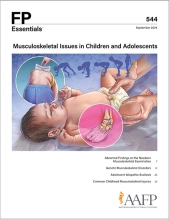
This clinical content conforms to AAFP criteria for CME.
Prenatal and delivery history guides a thorough musculoskeletal examination of the newborn. Amniotic bands from amniotic sequence/syndrome typically are apparent on visual inspection but may present as limb amputation. Management is guided by the degree of tissue compromise. Risk factors for birth trauma are maternal obesity, pelvic anomalies, macrosomia, and operative delivery. Fractures of the clavicle, humerus, and femur heal well with few sequelae. Splinting recommendations differ for each. Polydactyly, syndactyly, and clinodactyly are associated with syndromic conditions. In general, most are managed by orthopedists or plastic surgeons. Talipes equinovarus (clubfoot) can be diagnosed on prenatal ultrasonography, and 20% of cases are part of a syndromic condition. Treatment is via the Ponseti method and is followed by bracing, typically until age 5 years. Developmental dysplasia of the hip is a spectrum where the natural course is not clearly defined. Most instability initially discovered spontaneously resolves by age 2 months, and 90% resolves by age 12 months. Abduction splinting results in sustained hip reduction in 90% of infants requiring treatment.
Case 1. DD is a 1-day-old neonate born at term by cesarean delivery because of breech presentation. Barlow maneuver reveals a palpable clunk in her left hip that reduces with the Ortolani maneuver along with another palpable clunk. The physical examination is otherwise normal. At age 8 weeks, both maneuvers are positive. Ultrasonography shows the left femoral head is less than 50% covered by the bony acetabulum, consistent with developmental dysplasia of the hip (DDH).
Subscribe
From $350- Immediate, unlimited access to FP Essentials content
- 60 CME credits/year
- AAFP app access
- Print delivery available
Edition Access
$44- Immediate, unlimited access to this edition's content
- 5 CME credits
- AAFP app access
- Print delivery available
